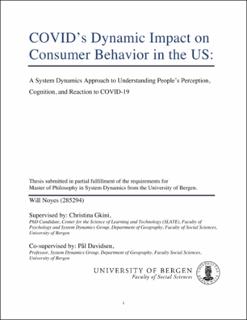COVID’s Dynamic Impact on Consumer Behavior in the US: A System Dynamics Approach to Understanding People’s Perception, Cognition, and Reaction to COVID-19
Master thesis

View/
Date
2021-06-04Metadata
Show full item recordCollections
- Master theses [125]
Abstract
COVID-19 has instigated sweeping and universal changes in how people carry on their day to day lives as they are forced to adjust to a constantly evolving pandemic. This research project investigates how general behavior patterns in many different industries have emerged from the evolving COVID pandemic. This project specifically considers theories from psychology and behavioral and cognitive science that are most likely to explain how people perceive, understand, and react to news about COVID (including anchoring and perception biases, Weber-Fechner’s laws of psychophysics, and the log-normal distribution of risk assessment for the population). These theories and cognitive mechanisms are then represented in a simulation model as a means of testing to what extent they are capable of explaining the time-series behavior data taken from a variety of industries and domains. The results have shown that a simple and general model of these cognitive mechanisms is able to substantially explain observed behavior patterns in many industries, including airline travel, dining at restaurants, workplace mobility, senior housing, and others. The result of this research provides a general model structure that, given reasonable parameterizations, offers a causal explanation as to how a population behaves at the aggregate level in a wide variety of domain just by accounting for some basic cognitive biases and heuristics. The insights provided by this model are both theoretical and practical. First, it offers a causal explanation of how COVID causes changes in behavior by means of the cognitive processes people undergo to perceive, understand, and react to COVID. Second, it offers a quantified explanation as to why behavior differs in different industries and domains by estimating a response distribution of the population for each particular domain. Third, it provides insights to policy makers and business managers as to how people may respond under different hypothetical COVID scenarios. Finally, it provides a general cognitive model structure that can be used in other COVID modeling projects or potentially other crisis situations beyond the COVID pandemic.